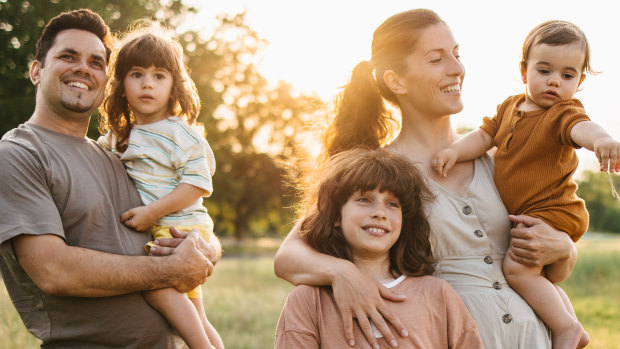Beige parenting is as boring as it sounds. So why is it trending?
If you’ve come across posts of kids wearing linen shirts and looking as though they’ve been living on a bucolic prairie for their short entire lives, or been stopped by scenes of toddlers playing with unpainted wooden blocks on jute rugs as you scroll through Instagram, you’re not looking at a photo shoot from Kinfolk Jnr magazine. It’s beige parenting, possibly the most boring aesthetic to ever influence our lives. And it’s everywhere.
The art of dressing your child in muted tones – creams, off-whites, ecrus, sands, oats, and as the name suggests, beiges, all the way up to earthy-brown tones – runs from head-to-toe: I’m talking tan caps, almond socks and mushroom sneakers, nary a pop of colour or personality to be seen. Though the trend has been around for a few years, Google searches for “beige kids clothes” increased by 67 per cent last year, and parental beigefluencers and their offspring have been trending on Instagram and TikTok ever since.

Beige parenting is the newest, arguably most boring, online trend.Credit: iStock
The roots of this ever-growing trend can be traced back to micro-influencers like Courtney Adamo, whose idyllic Byron Bay home and picture-perfect family pioneered the aesthetic for years, but took it mainstream when she and her fellow “murfers” (mum surfers) were profiled by Vanity Fair in 2019 (the profile quickly went viral).
As with all trends adopted by influencers, though, it’s not enough to just apply your chosen aesthetic of the day to just one area of your life. To be a trendsetter, the experience must be fully immersive. Like clothing, the trend itself must be embraced entirely across all aspects of your personal brand… I mean life. For Adamo, this translates to photos of herself with her five children, usually seen wearing an unofficial uniform of beige and cream (which neatly coordinates with her home’s colour palette) with her 260,000 Instagram followers.
Beige Parenting involves curated nurseries filled with a custom oak crib filled with cream throws, oat-coloured lamps sitting either side of an ecru-coloured flax linen nursing armchair and matching ottoman. Forget the traditional pink, blue, green or yellow – there are no jungle murals or hot air balloon decals here. This is where colour goes to die. The implicit marketing promise here is that within these neutral tones and calming hues awaits life devoid of tantrums or crayon marks on walls or yoghurt mashed into carpets. If you dress your child like an overpriced Scandinavian sack of potatoes and style their room like a tatami room, their behaviour will be just as serene.
In theory, being a minimalist is great and might be achievable when you’re child-free (or in the case of Kim Kardashian and Molly-Mae Hague have cleaners and nannies to keep your beige homes looking perfect and manage mountains of laundry). But for the average family, it’s impossible if for no other reasons than kids requiring a lot of paraphernalia and loving to make a lot of mess.
Aside from trying to style your child into the epitome of zen, the main problem with this is the impact removing colour (and spontaneity) from a child’s life can have. Colour has the ability to spark a child’s creativity and shape their personality. In a world where even their toys share the same colour scheme with the Saharan Desert, a kind of organic, boring version of Pleasantville is created.
For all those who have embraced beige parenting, though, there are those fighting back. Take DeRoche, the social media curator and author who coined the term “Sad Beige” and makes videos of beige clothing and toy catalogues while narrating them as if she were Werner Herzog.
For all the latest Life Style News Click Here
For the latest news and updates, follow us on Google News.
